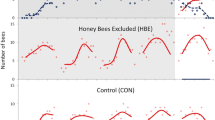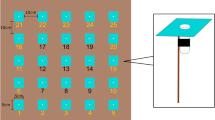Summary
To understand how a colony of honeybees keeps its forager force focussed on rich sources of food, and analysis was made of how the individual foragers within a colony decide to abandon or continue working (and perhaps even recruit to) patches of flowers. A nectar forager grades her behavior toward a patch in response to both the nectar intake rate of her colony and the quality of her patch. This results in the threshold in patch quality for acceptance of a patch being higher when the colonial intake rate of nectar is high than when it is low. Thus colonies can adjust their patch selectivity so that they focus on rich sources when forage is abundant, but spread their workers among a wider range of sources when forage is scarce. Foragers assess their colony's rate of nectar intake while in the nest, unloading nectar to receiver bees. The ease of unloading varies inversely with the colonial intake rate of nectar. Foragers assess patch quality while in the field, collecting nectar. By grading their behavior steeply in relation to such patch variables as distance from the nest and nectar sweetness, foragers give their colony high sensitivity to differences in profitability among patches. When a patch's quality declines, its foragers reduce their rate of visits to the patch. This diminishes the flow of nectar from the poor patch which in turn stimulates recruitment to rich patches. Thus a colony can swiftly redistribute its forager force following changes in the spatial distribution of rich food sources. The fundamental currency of nectar patch quality is not net rate of energy intake, (Gain-Cost)/Time, but may be net energy efficiency, (Gain-Cost)/Cost.
Similar content being viewed by others
References
Bastian J, Esch H (1970) The nervous control of the indirect flight muscles of the honey bee. Z Vergl Physiol 67:307–324
Boch R (1956) Die Tänze der Bienen bei nahen und fernen Trachtquellen. Z Vergl Physiol 38:136–167
Cahill K, Lustick S (1976) Oxygen consumption and thermoregulation in Apis mellifera workers and drones. Comp Biochem Physiol 55A:355–357
Deevey ES (1947) Life tables for natural populations of animals. Q Rev Biol 22:283–314
Frisch K von (1967) The dance language and orientation of bees. Harvard Univ Press, Cambridge (Massachusetts)
Gould JL, Henerey M, MacLeod MC (1970) Communication of direction by the honey bee. Science 169:544–554
Heinrich B (1978) The economics of insect sociality. In: Krebs JR, Davies NB (eds) Behavioural ecology: an evolutionary approach. Sinauer, Sunderland (Massachusetts) (pp 97–128)
Heinrich B (1980) Mechanisms of body-temperature regulation in honeybees, Apis mellifera. II. Regulation of thoracic temperature at high air temperatures. J Exp Biol 85:73–87
Kleiber M (1961) The fire of life: an introduction to animal energetics. Wiley, New York
Lindauer M (1948) Über die Einwirkung von Duft- und Geschmacksstoffen sowie anderer Faktoren auf die Tänze der Bienen. Z Vergl Physiol 31:348–412
Lindauer M (1954) Temperaturregulierung und Wasserhaushalt im Bienenstaat. Z Vergl Physiol 36:391–432
Lindauer M (1955) Schwarmbienen auf Wohnungssuche. Z Vergl Physiol 37:263–324
Lindauer M (1961) Communication among social bees. Harvard Univ Press, Cambridge (Massachusetts)
Louw GN, Hadley NF (1986) Water economy of the honeybee: a stoichiometric accounting. J Exp Zool (in press)
Meyer WH, Plusnin BA (1945) The Yale Forest in Tolland and Windham Counties, Connecticut. Yale Univ School Forest Bull 55:1–126
Neukirch A (1982) Dependence of the life span of the honeybee (Apis mellifica) upon flight performance and energy consumption. J Comp Physiol 146:35–40
Núñez JA (1966) Quantitative Beziehungen zwischen den Eigenschaften von Futterquellen und dem Verhalten von Sammelbienen. Z Vergl Physiol 53:142–164
Núñez JA (1970) The relationship between sugar flow and foraging and recruiting behaviour of honey bees (Apis mellifera L.). Anim Behav 18:527–538
Núñez JA (1982) Honeybee foraging strategies at a food source in relation to its distance from the hive and the rate of sugar flow. J Apic Res 21:139–150
Rinderer TE (1982) Regulated nectar harvesting by the honeybees. J Apic Res 21:74–87
Sakagami SF, Fukuda H (1968) Life tables for worker honeybees. Res Popul Ecol 10:127–139
Schmid-Hempel P, Kacelnik A, Houston AI (1985) Honeybees maximize efficiency by not filling their crop. Behav Ecol Sociobiol 17:61–66
Seeley TD (1985a) The information-center strategy of honeybee foraging. Fortschr Zool 31:75–90
Seeley TD (1985b) Honeybee ecology. A study of adaptation in social life. Princeton Univ Press, Princeton (New Jersey)
Seeley TD (1986) Social foraging by honeybees: the ability of colonies to find rich patches of flowers. Ecol Entomol (submitted)
Seeley TD, Visscher PK (1985) Survival of honeybees in cold climates: the critical timing of colony growth and reproduction. Ecol Entomol 10:81–88
Slobodkin LB (1961) Growth and regulation of animal populations. Holt, Rinehart and Winston, New York
Sokal RR, Rohlf FJ (1969) Biometry. Freeman, San Francisco
Visscher PK, Seeley TD (1982) Foraging strategy of honeybee colonies in a temperate deciduous forest. Ecology 63:1790–1801
Waddington K (1980) Flight patterns of foraging bees relative to density of artificial flowers and distribution of nectar. Oecologia 44:199–204
Waddington K (1982) Honey bee foraging profitability and round dance correlates. J Comp Physiol 148:297–301
Waddington K (1985) Cost-intake information used in foraging. J Insect Physiol 31:891–897
Withers P (1981) The effect of ambient air pressure on oxygen consumption of resting and hovering honeybees. J Comp Physiol 141:433–437
Author information
Authors and Affiliations
Rights and permissions
About this article
Cite this article
Seeley, T.D. Social foraging by honeybees: how colonies allocate foragers among patches of flowers. Behav Ecol Sociobiol 19, 343–354 (1986). https://doi.org/10.1007/BF00295707
Received:
Accepted:
Issue Date:
DOI: https://doi.org/10.1007/BF00295707




